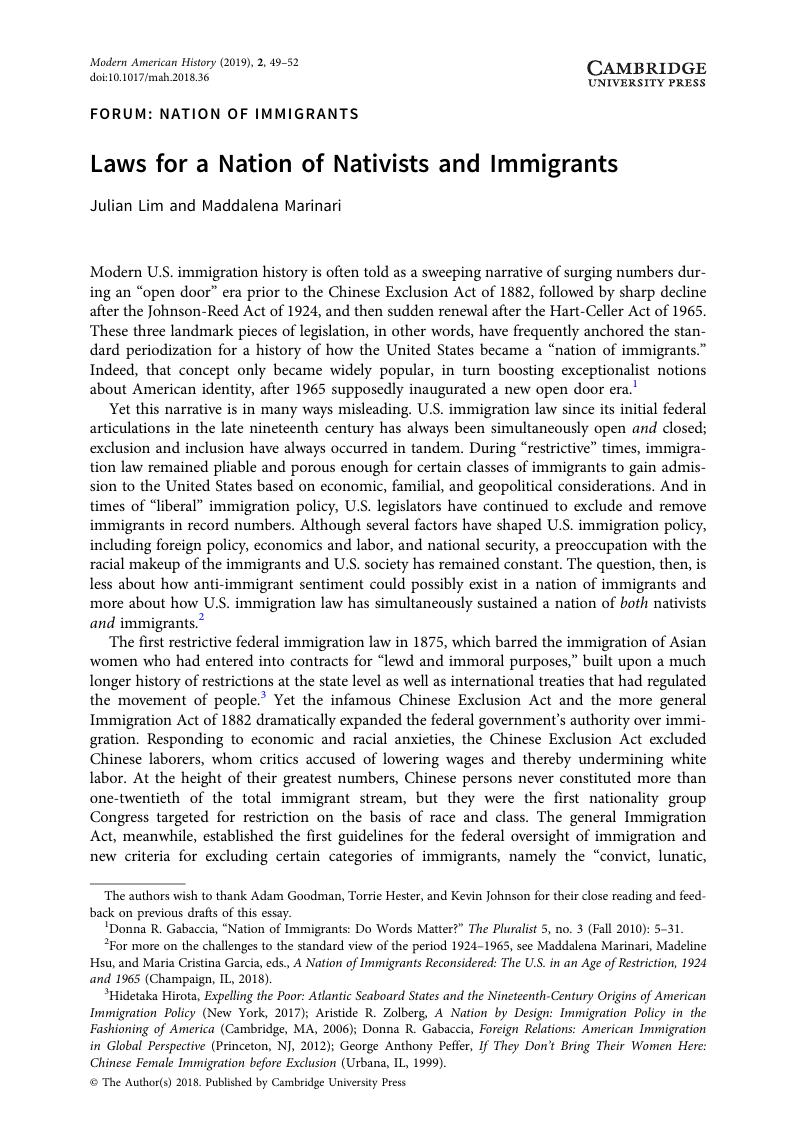Published online by Cambridge University Press: 20 November 2018

The authors wish to thank Adam Goodman, Torrie Hester, and Kevin Johnson for their close reading and feedback on previous drafts of this essay.
1 Gabaccia, Donna R., “Nation of Immigrants: Do Words Matter?” The Pluralist 5, no. 3 (Fall 2010): 5–31CrossRefGoogle Scholar.
2 For more on the challenges to the standard view of the period 1924–1965, see Marinari, Maddalena, Hsu, Madeline, and Garcia, Maria Cristina, eds., A Nation of Immigrants Reconsidered: The U.S. in an Age of Restriction, 1924 and 1965 (Champaign, IL, 2018)CrossRefGoogle Scholar.
3 Hirota, Hidetaka, Expelling the Poor: Atlantic Seaboard States and the Nineteenth-Century Origins of American Immigration Policy (New York, 2017)CrossRefGoogle Scholar; Zolberg, Aristide R., A Nation by Design: Immigration Policy in the Fashioning of America (Cambridge, MA, 2006)Google Scholar; Gabaccia, Donna R., Foreign Relations: American Immigration in Global Perspective (Princeton, NJ, 2012)CrossRefGoogle Scholar; Peffer, George Anthony, If They Don't Bring Their Women Here: Chinese Female Immigration before Exclusion (Urbana, IL, 1999)Google Scholar.
4 Immigration Act of 1882, 47 Congress, 1 Sess., Chapter 376, Aug. 3, 1882, 214.
5 Filipinos were an exception. As U.S. nationals, Filipinos were not allowed to become U.S. citizens but enjoyed the right of free movement between the United States and its territories until 1934, when the United States passed the Philippine Independence Act.
6 Muzaffar Chishti, Faye Hipsman, and Isabel Ball, “Fifty Years On, the 1965 Immigration and Nationality Act Continues to Reshape the United States,” Migration Information Source, Migration Policy Institute, Oct. 15, 2015, https://www.migrationpolicy.org/article/fifty-years-1965-immigration-and-nationality-act-continues-reshape-united-states (accessed June 1, 2018).
7 As noted above, prior to 1965, it was the Bracero Program that introduced a significant new stream of undocumented immigration from Mexico. See Hernández, Kelly Lytle, Migra! A History of the U.S. Border Patrol (Berkeley, CA, 2010), 109–17Google Scholar; Snodgrass, Michael, “The Bracero Program, 1942–1964,” in Beyond la Frontera: The History of Mexico-U.S. Migration, ed. Overmyer-Velázquez, Mark (New York, 2011), 91–2Google Scholar.
8 In 1976, Congress amended the act and imposed a 20,000 yearly cap on countries in the Western Hemisphere as well.